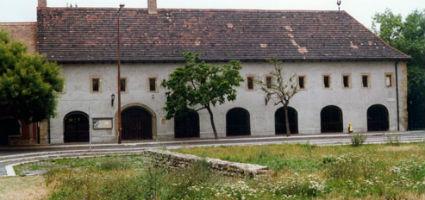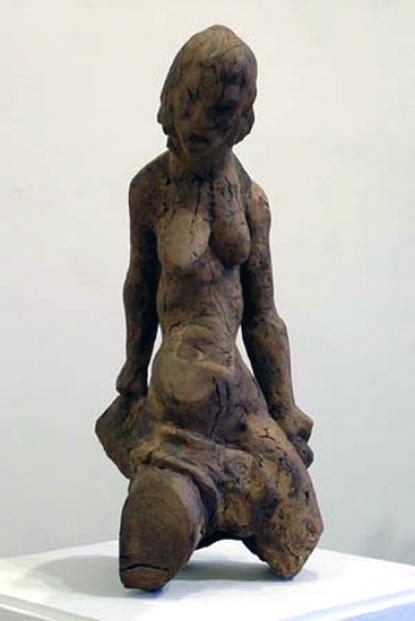2024. April 25. Thursday
Budapest Gallery Exhibition Hall - Budapest
 |
Address: 1036, Budapest Lajos u. 158.
Phone number: (1) 388-6784
E-mail: info@budapestgaleria.hu
Opening hours: Tue-Sun 10-18
|
The exhibition has closed for visitors.
2005.01.20. - 2005.02.20.
Mihály Dabóczi was the private pupil of Antal Orbán. He studied at the Collage of Fine Arts in 1931-1938 where his teacher was Zsigmond Kisfaludi Strobl. In 1936 he was awarded with the Ferenczy István Prize, in 1937-1938 he was a Kisfaludi scholar. In 1937 he was granted the sculptor scholarship of the Ministry of Religion and Public Education. In 1938-1939 he won a scholarship to Rome. In 1941 he won the prize of the Színyei Association. From 1952 he was a member of the Association of Spiritual Artists. He lived in Budapest from 1930. He was also known as a fencer in the 50's.

He began to exhibit his works in 1932. At first in 1932-1938 his works were characterized with academic naturalism. The time spent in Rome as a scholar significantly changed his art. He worked in the spirit of the Roman School. However, his mode of expression began to be similar to that of Medgyessy mainly in his small statues inspired by the life of the peasantry.
He continuously pondered on classic pictures that determined his unique voice. In the 1950's the effect of schematizm can be traced in his works especially on the ornaments. From the 1960's his figural compositions can be characterized by abstraction. In the last decade of his active creative life, he made cubist-constructivist-figurative small statues and wooden statues.
Man occupied the center of his thematic. He made nudes, portrayed the relationship between mother and child and made compositions on time, sports statues, portraits and animal figures. In his historic portraits, he tried to seize the spirituality of the person he portrayed. Besides the 40 statues erected his small statues and coins are also significant. He regularly participated at national fine art exhibitions and significant applications. (Hunyady, Metró).
(Contemporary Art Encyclopedia, Encyclopedia Press, Budapest, 1999, Volume 1. page 439, Zsuzsa Bánóczy)
HIS INDEPENDENT EXHIBITIONS :
1939 - Bragaglia - Róma
1942 - Ernst Museum, Budapest
1956 - One-man exhibition (Papp Gyulával)
1965 - One-man exhibition (With Kondor Béla)
1975 - Copper Embossments (Elektroncsőgyár, Kaposvár)
1980 - Adolf Fényes Ward, Budapest - Blaskovich Museum, Tápiószele

He began to exhibit his works in 1932. At first in 1932-1938 his works were characterized with academic naturalism. The time spent in Rome as a scholar significantly changed his art. He worked in the spirit of the Roman School. However, his mode of expression began to be similar to that of Medgyessy mainly in his small statues inspired by the life of the peasantry.
He continuously pondered on classic pictures that determined his unique voice. In the 1950's the effect of schematizm can be traced in his works especially on the ornaments. From the 1960's his figural compositions can be characterized by abstraction. In the last decade of his active creative life, he made cubist-constructivist-figurative small statues and wooden statues.
Man occupied the center of his thematic. He made nudes, portrayed the relationship between mother and child and made compositions on time, sports statues, portraits and animal figures. In his historic portraits, he tried to seize the spirituality of the person he portrayed. Besides the 40 statues erected his small statues and coins are also significant. He regularly participated at national fine art exhibitions and significant applications. (Hunyady, Metró).
(Contemporary Art Encyclopedia, Encyclopedia Press, Budapest, 1999, Volume 1. page 439, Zsuzsa Bánóczy)
HIS INDEPENDENT EXHIBITIONS :
1939 - Bragaglia - Róma
1942 - Ernst Museum, Budapest
1956 - One-man exhibition (Papp Gyulával)
1965 - One-man exhibition (With Kondor Béla)
1975 - Copper Embossments (Elektroncsőgyár, Kaposvár)
1980 - Adolf Fényes Ward, Budapest - Blaskovich Museum, Tápiószele
